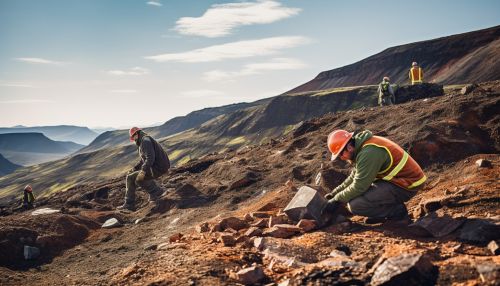Risk analysis in mineral exploration
Introduction
Risk analysis in mineral exploration is a crucial step in the decision-making process for mining companies. It involves the systematic identification, quantification, and assessment of the uncertainties and risks associated with the exploration of mineral resources. This process is essential for the effective management of resources, investment decisions, and strategic planning in the mining industry.


Risk Analysis: An Overview
Risk analysis is a comprehensive process that involves the identification, assessment, and prioritization of risks. In the context of mineral exploration, it refers to the systematic approach to understanding and managing the uncertainties and risks associated with the discovery and extraction of mineral resources. It involves a series of steps, including risk identification, risk assessment, risk mitigation, and risk monitoring.
Risk Identification
Risk identification is the first step in the risk analysis process. It involves the recognition of potential risks that could impact the success of mineral exploration activities. These risks can be categorized into geological risks, technical risks, financial risks, environmental risks, and socio-political risks.
Geological Risks
Geological risks refer to the uncertainties associated with the geological characteristics of the mineral deposit. These include the size, grade, and continuity of the mineral deposit, as well as the presence of deleterious elements. Geological risks are inherent in mineral exploration and cannot be completely eliminated. However, they can be managed and mitigated through careful geological modeling and resource estimation.
Technical Risks
Technical risks are associated with the technologies and methods used in mineral exploration and extraction. These include risks related to drilling, sampling, assaying, and mineral processing. Technical risks can be managed through the use of advanced technologies and techniques, as well as through rigorous quality control and quality assurance procedures.
Financial Risks
Financial risks refer to the uncertainties related to the financial aspects of mineral exploration. These include risks related to capital availability, cost overruns, commodity price fluctuations, and exchange rate fluctuations. Financial risks can be managed through careful financial planning and risk management strategies.
Environmental Risks
Environmental risks are associated with the potential environmental impacts of mineral exploration and extraction. These include risks related to land disturbance, water contamination, air pollution, and biodiversity loss. Environmental risks can be managed through the implementation of environmental management systems and sustainable mining practices.
Socio-Political Risks
Socio-political risks refer to the uncertainties related to the social and political environment in which mineral exploration activities take place. These include risks related to community relations, land tenure, regulatory compliance, and political instability. Socio-political risks can be managed through stakeholder engagement, corporate social responsibility initiatives, and political risk insurance.
Risk Assessment
Risk assessment is the process of evaluating the likelihood and potential impact of identified risks. In mineral exploration, risk assessment involves the use of quantitative and qualitative methods to estimate the probability and consequences of geological, technical, financial, environmental, and socio-political risks.
Quantitative risk assessment involves the use of statistical and mathematical models to estimate the probability and impact of risks. This includes methods such as probabilistic resource estimation, Monte Carlo simulation, and decision tree analysis.
Qualitative risk assessment involves the use of expert judgment and experience to assess the likelihood and consequences of risks. This includes methods such as risk ranking, risk matrix, and expert elicitation.
Risk Mitigation
Risk mitigation involves the development and implementation of strategies to manage and reduce the impact of risks. In mineral exploration, risk mitigation strategies can include geological modeling, resource estimation, technological innovation, financial planning, environmental management, stakeholder engagement, and political risk insurance.
Risk Monitoring
Risk monitoring is the ongoing process of tracking the identified risks and evaluating the effectiveness of the risk mitigation strategies. It involves the regular review and update of the risk analysis process to reflect changes in the risk environment.
Conclusion
Risk analysis in mineral exploration is a critical process that enables mining companies to manage the uncertainties and risks associated with the discovery and extraction of mineral resources. By identifying, assessing, mitigating, and monitoring risks, companies can make informed decisions, manage resources effectively, and plan strategically for the future.
